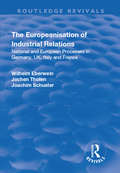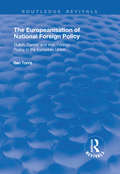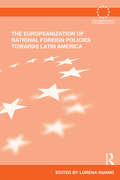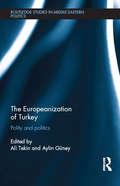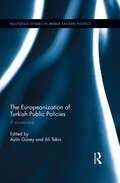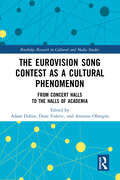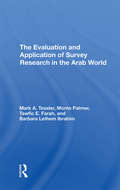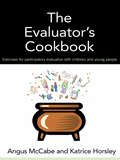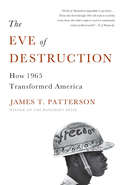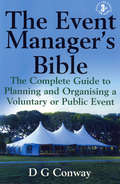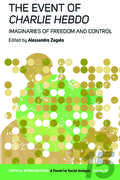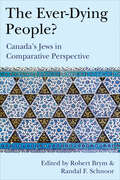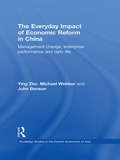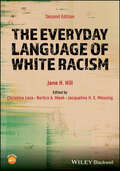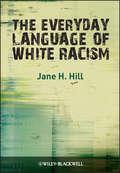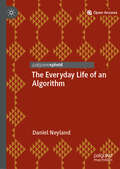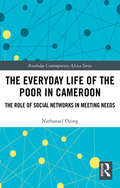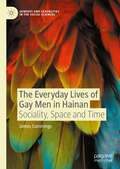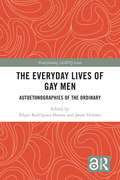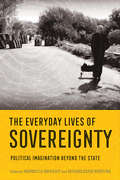- Table View
- List View
The European Yearbook of Business History: Volume 2 (Routledge Revivals #1)
by Terry Gourvish Wilfried FeldenkirchenFirst published in 1999, this volume aims to reflect on the changing structure, experience and aspirations of European business as it approaches the Millennium, including chapters in issues including business scandals in the Weimar Republic, the evolution of management consultancies in Portugal and Spain and the British Public Sector. The yearbook exploits these changes by serving as a forum for debate in Europe and aims to bring work on individual countries to a wider, European audience. Responding to the challenge of globalization, cooperation within a single European market and an increasing interest in corporate governance and environmental issues, the yearbook broadens to include socio-political issues along with stimulating new types of scholarship among European business historians and new preservation strategies by business archivists.
The Europeanisation of Industrial Relations: National and European Processes in Germany, UK, Italy and France (Routledge Revivals)
by Wilhelm Eberwein Jochen Tholen Joachim SchusterThis title was first published in 2002: Although the economic integration of the European Union is far-advanced, its social dimension remains under-developed. Often there is uncertainty about, and lack of information on, the economic, social and legal situation of employees in the other EU countries. This study investigates this situation. It acknowledges the term "Europeanization" as being in no way clearly defined, but offers an interpretation of the Europeanization of industrial relations as a socio-political process, with the main focus the change within the plant and organization. Industrial relations in Germany are used as a point of reference against which selected aspects of industrial relations in France, the UK, and Italy are compared and contrasted. Specific areas of study include: workplace and company organization; collective bargaining; trade unions and employers' associations; and government regulations and legislative standardization.
The Europeanisation of National Foreign Policy: Dutch, Danish and Irish Foreign Policy in the European Union
by Ben TonraThis title was first published in 2001. This study questions whether the development of foreign and security policy co-operation within the EU has constrained or empowered Danish, Dutch and Irish foreign policy. This entails a study of the relationship between national foreign policy and EU frameworks for co-operation.
The Europeanization of National Foreign Policies towards Latin America (Routledge Advances in European Politics)
by Lorena RuanoWho shapes the European Union’s policy towards Latin America? How has this EU policy modified individual member states’ relations with the region? This book provides a comparative account of seven member states’ bilateral links with Latin America since 1945, in the context of their EU membership and based on the concept of ‘Europeanization’. It illustrates how and why the main architects of this EU policy have been Spain and Germany. In contrast, Poland, Sweden and Ireland, which had little previous interaction with Latin America, have developed their current relations with that region virtually as a result of their EU membership. The United Kingdom and France lie in the middle: they have been influential in certain policy-areas and key periods in history, while they have adapted to what is done at the EU level in others. Practitioners, established academic experts as well emerging scholars in the field bring to be bear a novel combination of pioneering research and cutting edge conceptual analysis on this important but neglected area of the EU’s foreign relations.
The Europeanization of Turkey: Polity and Politics (Routledge Studies in Middle Eastern Politics)
by Ali Tekin Aylin GüneyGiven the recent inertia in EU-Turkey relations in the midst of regional economic and political upheavals, Europeanization of Turkey takes a step back from the latest headlines to provide a comprehensive stocktaking of EU-inspired reform efforts in Turkey with an eye to understanding how effective or ineffective EU conditionality has been in making Turkey's key political institutions, actors and culture more compatible with European norms. In addition to contributing to the theoretical literature on the differential effects of Europeanization on the domestic realm, this volume also expands the existing scope of research to include questions of how socialization through the accession process operates under high levels of uncertainty about the attainability of European Union membership. Applying a uniform analytical framework and the methodology of process tracing, the authors in this volume assess the nature and degree of change that has occurred in various dimensions of Turkish domestic polity and politics in the context of Turkey's post-1999 EU accession. Engaging with important practical issues such as whether potential membership in the EU has brought about positive change, in which areas this change is manifest, and how significant this change has been, this book is an essential resource for students, scholars and researchers seeking to understand contemporary relations between the EU and Turkey.
The Europeanization of Turkish Public Policies: A Scorecard (Routledge Studies in Middle Eastern Politics)
by Ali Tekin Aylin GüneyTurkey’s candidacy for membership of the European Union has had mixed effects on its public policies. The initial degree of cohesion between EU and Turkish national policies, practices and institutions has varied by the policy field in question, leading to a complex amalgam of fit and misfit between the two actors. Their interaction in different policy areas has had direct influence both on Turkey’s accession to the EU and its own national reform process. With accession negotiations stalled and Turkey’s relationship with the EU increasingly tenuous, it is vital to take stock of the extent to which Turkey and the EU are aligned in key policy areas. The Europeanization of Turkish Public Policies: A Scorecard is the first comprehensive work focusing on the impact of the EU accession process upon Turkey’s public policies between 1999 and 2014. Complementing the authors’ earlier volume Europeanization of Turkey: Polity and Politics, it brings together leading specialists to provide key analyses of the impact of Europeanization on specific areas of Turkey’s public policy. Each chapter applies a core analytical framework to examine a separate policy field, resulting in a consistent and comprehensive volume on Turkey-EU relations. With its focused structure and extensive coverage, concluding with a scorecard enabling informed assessment of the impact of Europeanization on Turkey’s public policy areas, this book provides a one-stop resource for scholars and students alike. A timely and informed assessment of the dynamics and outcome of the Europeanization of an EU candidate country’s major public policy areas, this book represents an essential resource for those interested in EU-Turkey relations, the effects of Europeanization on Turkey, and Turkish politics.
The Eurovision Song Contest as a Cultural Phenomenon: From Concert Halls to the Halls of Academia (Routledge Research in Cultural and Media Studies)
by Antonio ObregónDrawing from the wealth of academic literature about the Eurovision Song Contest (ESC) written over the last two decades, this book consolidates and recognizes the ESC's relevance in academia by analysing its contribution to different fields of study. The book brings together leading ESC scholars from across disciplines and from across the globe to reflect on the intersection between their academic fields of study and the ESC by answering the question: what has the ESC contributed to academia? The book also draws from fields rarely associated with the ESC, such as Law, Business and Research Methodologies, to demonstrate the contest's broad utility in research, pedagogy and in practice. Given its interdisciplinary approach, this volume will be of interest to scholars and students working in cultural, media, and music studies, as well as those interested in the intersections between these areas and politics, law, education, pedagogy, and history.
The Evaluation And Application Of Survey Research In The Arab World
by Mark Tessler Tawfic E Farah Monte Palmer Barbara IbrahimAt a time when survey research is increasingly being conducted in the Arab world, there is also growing concern about the degree to which research assumptions and methods developed in the West are appropriate for use in the study of Arab society. This book assesses the application and limits of survey research performed in the Arab world, reviews the surveys currently being used to study public attitudes and behavior patterns, and discusses epistemological, methodological, and ethical issues associated with these studies. Readers are alerted to normative and empirical considerations bearing on the quality of survey research and given practical suggestions for innovation in the design and execution of survey research and in the analysis of survey data. The book raises intellectual issues of concern to all who seek to better understand Arab society and provides extensive information about attitudes and behavior in the Arab world.
The Evaluator's Cookbook: Exercises for participatory evaluation with children and young people
by Angus McCabe Katrice HorsleyParticipation is a vital element of working with children and young people – ensuring that services are meeting their needs as well as promoting citizenship, resilience and general well-being. The Evaluator’s Cookbook contains 21 participatory evaluation exercises for use with children, young people and families/community groups. Attractively and clearly presented, the exercises are very easy to use and come with suggestions for use and instructions on how to create the equipment needed. They will appeal to a wide range of people and can be used in a variety of informal and formal settings and most of the exercises are suitable for use with disabled children or children with special needs, as well as people with English as a second language. The book also explores why, how and where participatory research and evaluation should take place and provides suggestions on how the findings can be presented in imaginative ways. This unique book is an invaluable resource for those wishing to consult with children and families or evaluate social, health and education services in diverse cultural settings.
The Evangelical Counter-Enlightenment: From Ecstasy to Fundamentalism in Christianity, Judaism, and Islam in the 18th Century (Boston Studies in Philosophy, Religion and Public Life #9)
by William R. EverdellThis contribution to the global history of ideas uses biographical profiles of 18th-century contemporaries to find what Salafist and Sufi Islam, Evangelical Protestant and Jansenist Catholic Christianity, and Hasidic Judaism have in common. Such figures include Muḥammad Ibn abd al-Waḥhab, Count Nikolaus Zinzendorf, Jonathan Edwards, John Wesley, Jean-Jacques Rousseau, and Israel Ba’al Shem Tov. The book is a unique and comprehensive study of the conflicted relationship between the “evangelical” movements in all three Abrahamic religions and the ideas of the Enlightenment and Counter-Enlightenment. Centered on the 18th century, the book reaches back to the third century for precedents and context, and forward to the 21st for the legacy of these movements. This text appeals to students and researchers in many fields, including Philosophy and Religion, their histories, and World History, while also appealing to the interested lay reader.
The Eve of Destruction: How 1965 Transformed America
by James T. PattersonOf all the changes that have swept across America in the past century, perhaps none have been as swift or dramatic as those that transpired in the 1960s. The United States entered the decade still flush with postwar triumphalism, but left it profoundly changed: shaken by a disastrous foreign war and unhinged by domestic social revolutions and countercultural movements that would define the nation''s character, politics, and policies for decades to come. The prevailing understanding of the 1960s traces its powerful shockwaves to 1968, a year of violent protests and tragic assassinations. But in The First Year of the Sixties, esteemed historian James T. Patterson shows that it was actually in 1965 that America truly turned a corner and entered the new, tumultuous era we now know as "The Sixties. " In the early 1960s, America seemed on the cusp of a golden age. Political liberalism, national prosperity, and interracial civil rights activism promised positive change for many Americans. Although the nation had been shocked by the 1962 Cuban Missile Crisis and the 1963 assassination of President Kennedy, America''s fundamental traditions and mores remained intact. It was a time of consensus and optimism, and popular culture reflected this continuity. Young people dressed and behaved almost exactly as they did in the 1950s, and if the music and hairstyles of the British Invasion worried some conservative parents, these concerns were muted. At the beginning of 1965, Americans saw no indication that the new year would be any different. In January, President Johnson proclaimed that the country had "no irreconcilable conflicts. " Initially, events seemed to prove him right. The economy continued to boom, and the overwhelmingly Democratic Congress passed a host of historic liberal legislation, from the Voting Rights Act to Medicare and Medicaid to expansions of federal aid for education and the war on poverty. But Patterson shows that, even amidst these reassuring developments, American unity was unraveling. Turmoil erupted in the American South and overseas in the spring of 1965, with state troopers attacking civil rights demonstrators in Selma, Alabama and American combat troops rushing into Vietnam to protect American interests there. Many black leaders, meanwhile, were becoming disenchanted with nonviolence, and began advocating instead for African-American militancy. That summer, as anti-war protests reached a fever pitch, rioting exploded in the Watts area of Los Angeles; the six days of looting and fires that followed shocked many Americans and cooled their enthusiasm for the president''s civil rights initiatives, which--like his other "Great Society" programs--were also being steadily undermined by the costly and unpopular war in Vietnam. Conservative counterattacks followed, with Republicans like California gubernatorial candidate Ronald Reagan--and even some disillusioned Democrats--criticizing the President for mismanaging the war and expanding the federal government past its manageable limits. As Patterson explains, this growing pessimism permeated every level of society. By the end of 1965 the national mood itself had darkened, as reflected in a new strain of anti-establishment rock music by artists like the Rolling Stones, Bob Dylan, the Grateful Dead, and Jefferson Airplane. Their songs and lyrics differed dramatically from the much more staid recordings of contemporary acts like Frank Sinatra, Julie Andrews, and the Supremes, reflecting an alienation from mainstream American culture shared by an increasing number of young Americans. In The First Year of the Sixties, James T. Patterson traces the transformative events of this critical year, showing how 1965 saw an idealistic and upbeat nation derailed by developments both at home and abroad. An entire generation of Americans--as well as the country''s politics, culture, race relations, and foreign policies--would never be the same.
The Evening Crowd At Kirmser's: A Gay Life In The 1940s
by Ricardo Brown William Reichard Allan H. SpearSet in 1945-1946, documentary of a WWII vet discharged for homosexuality and gay life at the time period.
The Event Manager's Bible 3rd Edition: The Complete Guide to Planning and Organising a Voluntary or Public Event
by D.G. ConwayAnyone responsible for organising a voluntary or public event will want to do it safely and well, complying with the legislation relating to different aspects of their event. This book will help you to research, plan, organise, manage and deliver any event, match, show, tournament or function that will be attended by more than a handful of people. You may be running a gymkhana, fete, fun run, steam fayre, half marathon, carnival, school sports day, jumble sale, tennis tournament, car boot sale, model aircraft show or even a huge pop festival or Formula 1 car race. Whatever it is, the principles are the same. As event manager you will need to research, plan, liaise with authorities, obtain permissions and licences, comply with legal requirements and then deliver the event to the public.Contents: 1. Introduction; 2. The event manager; 3. The event objective; 4. Planning the event; 5. Health & safety; 6. Type of event; 7. When to run the event; 8. Defining your target audience; 9. Audience size; 10. Advertising; 11. Event attractions; 12. Event requirements; 13. Accommodation and services; 14. Event site; 15. Traffic management; 16. Sign posting; 17. Permissions; 18. Car parking; 19. Radio communications; 20. Staffing; 21. First aid; 22. Security; 23. Insurance; 24. Emergency and normal procedures; 25. Formal presentation; 26. Event manager's manual; 27. Money; 28. Accounts; 29. Video diary/evidence; 30. Setting up; 31. Site maintenance; 32. Strip down/clear up; 33. Final debrief &; 34. Final report; 35. Conclusion; Annex A; Annex B; Index.
The Event Manager's Bible: The Complete Guide to Planning and Organising a Voluntary or Public Event
by D. G. ConwayAnyone responsible for organising a voluntary or public event will want to do it safely and well, complying with the legislation relating to different aspects of their event. This book will help you to research, plan, organise, manage and deliver any event, match, show, tournament or function that will be attended by more than a handful of people. You may be running a gymkhana, fete, fun run, steam fayre, half marathon, carnival, school sports day, jumble sale, tennis tournament, car boot sale, model aircraft show or even a huge pop festival or Formula 1 car race. Whatever it is, the principles are the same. As event manager you will need to research, plan, liaise with authorities, obtain permissions and licences, comply with legal requirements and then deliver the event to the public.Contents: 1. Introduction; 2. The event manager; 3. The event objective; 4. Planning the event; 5. Health & safety; 6. Type of event; 7. When to run the event; 8. Defining your target audience; 9. Audience size; 10. Advertising; 11. Event attractions; 12. Event requirements; 13. Accommodation and services; 14. Event site; 15. Traffic management; 16. Sign posting; 17. Permissions; 18. Car parking; 19. Radio communications; 20. Staffing; 21. First aid; 22. Security; 23. Insurance; 24. Emergency and normal procedures; 25. Formal presentation; 26. Event manager's manual; 27. Money; 28. Accounts; 29. Video diary/evidence; 30. Setting up; 31. Site maintenance; 32. Strip down/clear up; 33. Final debrief &; 34. Final report; 35. Conclusion; Annex A; Annex B; Index.
The Event of Charlie Hebdo
by Alessandro ZagatoThe January 2015 shooting at the headquarters of satirical magazine Charlie Hebdo in Paris and the subsequent attacks that took place in the Ile-de-France region were staggeringly violent events. They sparked an enormous discussion among citizens and intellectuals from around Europe and beyond. By analyzing the effects the attacks have had in various spheres of social life, including the political, ideology, collective imaginaries, the media, and education, this collection of essays aims to serve as a contribution as well as a critical response to that discussion. The volume observes that the events being attributed to Charlie Hebdo go beyond sensationalist reports of the mainstream media, transcend the spatial confines of nation states, and lend themselves to an ever-expanding number of mutating discursive formations.
The Ever-Changing Sino-Japanese Rivalry (Politics in Asia)
by Philip StreichWhat explains the ebb and flow of the Sino-Japanese rivalry? Why do the two states sometimes choose to escalate or de-escalate the rivalry? Does domestic politics play a role? Examining the historic and contemporary relationship between China and Japan through the lens of the interstate rivalry literature, Streich analyzes two periods of Sino-Japanese rivalry and the reasons for their ever-changing nature. He looks both at how rivalry theory can help us to understand the relationship between the two countries and how this relationship can in turn inform rivalry theory. His results find that domestic politics and expected costs play a large role in determining when each state decides when to escalate, de-escalate, or maintain the status quo. This book is an essential guide to understanding the historical development and contemporary status of the Sino-Japanese rivalry.
The Ever-Dying People?: Canada’s Jews in Comparative Perspective
by Randal F. Schnoor Robert BrymDemise by assimilation or antisemitism is often held to be the inevitable future of Jews in Canada and other diaspora countries. The Ever-Dying People? shows that the Jewish diaspora, while often held to be in decline, is influenced by a range of identifiable sociological and historical forces, some of which breathe life into Jewish communities, including Canada’s. Bringing together leading Canadian and international scholars, The Ever-Dying People? provides a landmark report on Canadian Jewry based on recent surveys, censuses, and other contemporary data sources from Canada and around the world. This collection compares Canada’s Jews with other Canadian ethnic and religious groups and with Jewish communities in other diaspora countries, including the United States, the United Kingdom, France, and Australia. It also sheds light on social divisions within Canadian Jewry: across cities, sub-ethnic groups, denominations, genders, economic strata, and political orientations. These bases of comparison usefully explain variation in a wide range of sociological phenomena, including ethnic identity, religiosity, acculturation, intermarriage, discrimination, economic achievement, and educational attainment.
The Everyday Impact of Economic Reform in China: Management Change, Enterprise Performance and Daily Life (Routledge Studies in the Growth Economies of Asia)
by John Benson Ying Zhu Michael WebberDuring the past 30 years, China has undergone extensive economic reform, replacing the government’s administration of enterprises with increasing levels of market-oriented enterprise autonomy. At the heart of the reform are changes in the employment relationship, where state control has been superceded by market relationships. These reforms have had far-reaching implications for many aspects of everyday life in Chinese society. This book appraises the impact of the economic reforms on the employment relationship and, in turn, examines the effects on individual workers and their families, including salaries, working conditions and satisfaction, job security and disparities based on location, gender, age, skill, position and migrant status. In particular, it focuses on how changes in the employment relationship have affected the livelihood strategies of households. It explores the changing human resource management practices and employment relations in different types of enterprises: including State-Owned Enterprises, Foreign-Owned Enterprises and Domestic Private Enterprises; throughout different industries, focusing especially on textiles, clothing and footwear and the electronics industry; and in different regions and cities within China (Beijing, Haerbin, Lanzhou, Hangzhou, Wuhan and Kunming). Overall, this book provides a detailed account of the everyday implications of economic reform for individuals and families in China.
The Everyday Language of White Racism (Wiley Blackwell Studies in Discourse and Culture)
by Jane H. HillA groundbreaking critical discourse analysis of everyday language, reveals the underlying racist stereotypes circulating in American culture In The Everyday Language of White Racism, prominent linguist Jane H. Hill provides an incisive analysis of the relationship between language, race, and culture. First published in 2008, this classic textbook employs an innovative framework to reveal the underlying racist stereotypes that continue to persist in White American culture and sustain structures of White Supremacy. Detailed yet accessible chapters integrate a broad range of literature from across disciplines, including sociology, social psychology, critical legal studies, anthropology, and sociolinguistics. Throughout the book, students are encouraged to engage with the linguistic data available through observation of racialized communication in their everyday lives. Edited by a team of leading scholars, the second edition of The Everyday Language of White Racism brings Hill's contributions to the study of racism into conversation with the most current literature on language and racism in the United States. Topics such as racial profiling, police violence, the Black Lives Matter movement, White nationalism, White fragility, and various forms of institutional racism are addressed within Hill's broader framework of White racial projects and the “White folk” theory of race and racism. New chapter-by-chapter annotations clarify and contextualize theoretical concepts, accompanied by new discussion questions that offer guidance for analytical conversations in classrooms. Provides resources for critical discussions on contemporary racial issues that continue to limit and endanger BIPOC (Black, Indigenous, and People of Color) individuals and communities Dispels the common assumption that White racism is fading in the US and the Western world Illustrates how racist effects can be produced in interaction without any single person intending discrimination Contains an overview of the theory of race and racism, with definitions of terms and concepts Includes recent statistical data on U.S. racial gaps across a variety of categories and access to a companion website with additional resources The Everyday Language of White Racism, Second Edition remains an indispensable resource for undergraduate and graduate students in Critical Race Studies and Linguistic Anthropology courses across the Humanities and Social Sciences.
The Everyday Language of White Racism: History, Theory, And Method (Wiley Blackwell Studies in Discourse and Culture #7)
by Jane H. HillIn The Everyday Language of White Racism, Jane H. Hill provides an incisive analysis of everyday language to reveal the underlying racist stereotypes that continue to circulate in American culture. provides a detailed background on the theory of race and racism reveals how racializing discourse—talk and text that produces and reproduces ideas about races and assigns people to them—facilitates a victim-blaming logic integrates a broad and interdisciplinary range of literature from sociology, social psychology, justice studies, critical legal studies, philosophy, literature, and other disciplines that have studied racism, as well as material from anthropology and sociolinguistics Part of the Blackwell Studies in Discourse and Culture Series
The Everyday Life of an Algorithm
by Daniel NeylandThis open access book begins with an algorithm–a set of IF…THEN rules used in the development of a new, ethical, video surveillance architecture for transport hubs. Readers are invited to follow the algorithm over three years, charting its everyday life. Questions of ethics, transparency, accountability and market value must be grasped by the algorithm in a series of ever more demanding forms of experimentation. Here the algorithm must prove its ability to get a grip on everyday life if it is to become an ordinary feature of the settings where it is being put to work. Through investigating the everyday life of the algorithm, the book opens a conversation with existing social science research that tends to focus on the power and opacity of algorithms. In this book we have unique access to the algorithm’s design, development and testing, but can also bear witness to its fragility and dependency on others.
The Everyday Life of the Poor in Cameroon: The Role of Social Networks in Meeting Needs (Routledge Contemporary Africa)
by Nathanael OjongThis book provides a detailed account of the lives of the poor, particularly their use of social networks to meet everyday needs.Based on fieldwork in Cameroon, the book provides a distinctive approach that draws on social network theory and insights from economic anthropology to shed light on how the poor make a living. Though embeddedness in social networks is essential to human achievement, we know little about the social and cultural forces and processes that shape poor people’s decisions to seek help from strong, weak, and disposable ties in an African context. Focusing on network practice rather than network structure, the author argues that the ability of poor people to meet their diverse needs rests on several elements, such as favourable interactions and social and cultural forces. He examines various issues crucial to the lives of the poor, such as food, shelter, healthcare, death and funerals, and access to finance. Particular focus is given to the complicated nature of social relationships, the different contexts where these relationships take place, and how these factors shape poor individuals’ decisions regarding whom to turn to when attempting to meet their needs, including how they actually meet those needs.This book will be of interest to researchers, teachers, students, and policy-makers in African Studies economics, development studies, sociology, and anthropology.
The Everyday Lives of Gay Men in Hainan: Sociality, Space and Time (Genders and Sexualities in the Social Sciences)
by James Cummings“This book explores the everyday lives of gay men in Hainan, an island province of the People’s Republic of China. Taking an ethnographic and phenomenological approach, it asks how these men construct and experience ways of ‘sexual being’ – as gay, homosexual, tongzhi and/or in the scene – and what these mean for the ways of living they see as possible within a socio-cultural, political and material context characterised by pervasive heteronormativity. It explores what it means for gay men in Hainan to ‘come into the scene’, how internet and mobile technologies figure in their everyday processes of sexual categorisation and how these men negotiate orientations and disorientations towards the future in relation to dominant heterosexual life scripts of marriage and reproduction. This book offers vital insights into the production and restriction of non-heterosexual lives in diverse settings, while addressing universal questions of how certain ways of living are enabled and curtailed in living together with others through powerful conditions of uncertainty and precarity. This book will be of interest to scholars in LGBTQ studies, particularly those with a focus on same-sex intimacies and identities in China.”
The Everyday Lives of Gay Men: Autoethnographies of the Ordinary (Transforming LGBTQ Lives)
by Edgar Rodríguez-Dorans and Jason HolmesThe Everyday Lives of Gay Men draws on the expertise of 12 contributors from different countries and fields, writing from an autoethnographic first-person approach. Putting the power of personal stories at the centre of the construction of sophisticated narratives of gay men’s lives, the accounts draw attention to the limits of traditional perspectives to gay men’s studies that look at gayness through a sexualised lens and explore how gay men make sense of their identity in their everyday lives. Together they present a complex, nuanced understanding of gayness and challenge the conception of ‘being gay’ as a sexual orientation because it describes in sexual terms an identity that is not only, not always, and not predominantly sexual. The authors come from a variety of fields, including counselling studies and sociology, to communication, religion, and education. The innovative approach of The Everyday Lives of Gay Men makes it ideal for students and scholars in gender studies, sexuality studies, sociology, mental health, and research methods. The Open Access version of this book, available at www.taylorfrancis.com/books/e/9780367676834, has been made available under a Creative Commons Attribution-Non Commercial-No Derivatives 4.0 license.
The Everyday Lives of Sovereignty: Political Imagination beyond the State
Around the world, border walls and nationalisms are on the rise as people express the desire to "take back" sovereignty. The contributors to this collection use ethnographic research in disputed and exceptional places to study sovereignty claims from the ground up. While it might immediately seem that citizens desire a stronger state, the cases of compromised, contested, or failed sovereignty in this volume point instead to political imaginations beyond the state form. Examples from Spain to Afghanistan and from Western Sahara to Taiwan show how calls to take back control or to bring back order are best understood as longings for sovereign agency. By paying close ethnographic attention to these desires and their consequences, The Everyday Lives of Sovereignty offers a new way to understand why these yearnings have such profound political resonance in a globally interconnected world. Contributors: Panos Achniotis, Jens Bartelson, Joyce Dalsheim, Dace Dzenovska, Sara L. Friedman, Azra Hromadžić, Louisa Lombard, Alice Wilson, and Torunn Wimpelmann.

